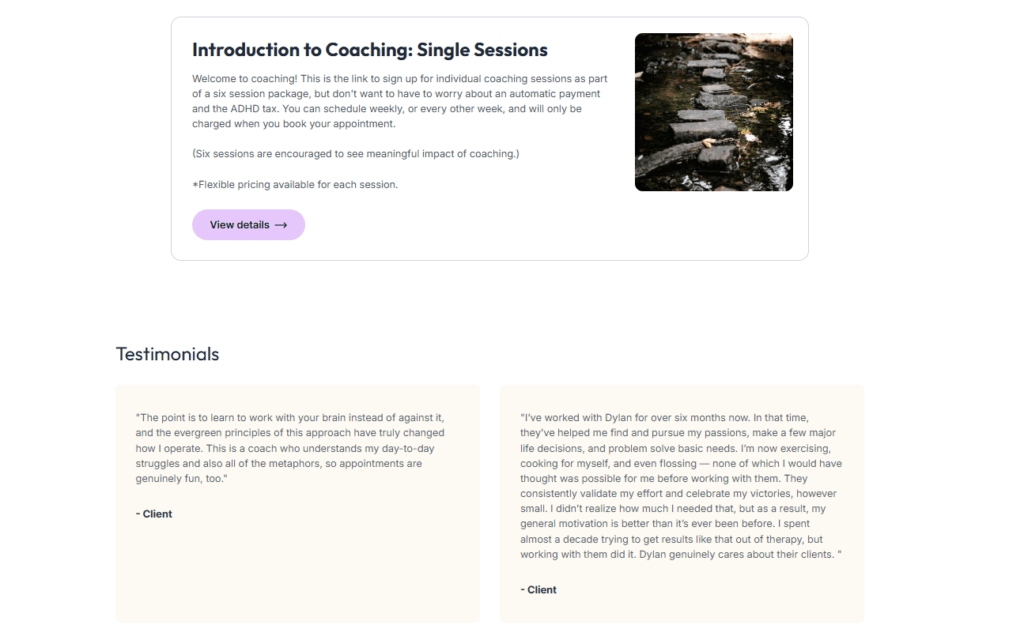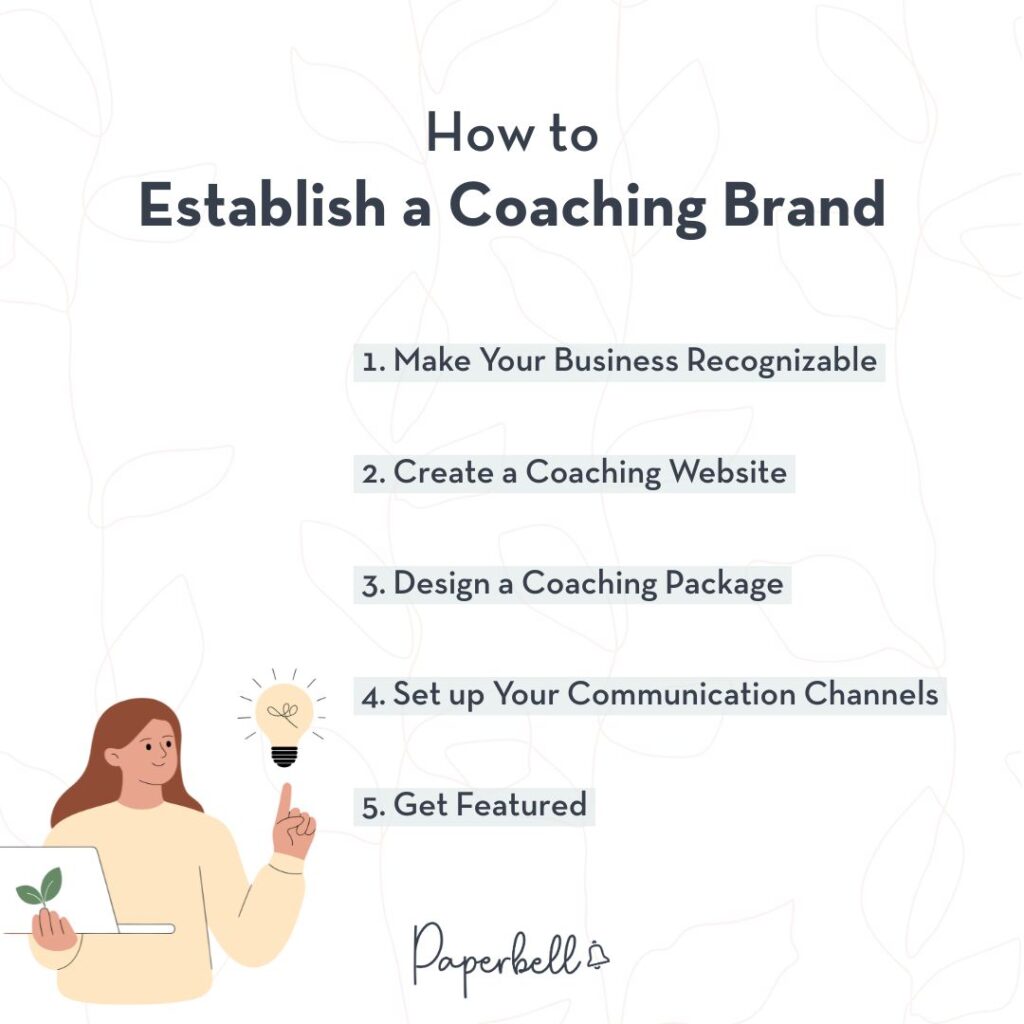If you’re considering a career change that’s both fulfilling and financially rewarding, life coaching might be the answer. As a professional coach, you can make a meaningful difference in people’s lives while designing your work life the way you want to.
However, breaking into this fast-growing field can be challenging. There are many ways to become a life coach, but there are some requirements you can’t skip. Pursuing life coach training and developing your own personal coaching presence are essential steps.
In this guide, we’ll explore the step-by-step process of becoming a successful life coach:
- Expand your business
- Acquire core coaching skills
- Build your methodology
- Gain coaching experience
- Set up a business
- Choose a niche
- Set up the admin side of your business
- Establish a brand
1. Acquire Core Coaching Skills
Whether you have formal training in coaching or not, there are a few essential skills that you need to work on with clients.
Here are the most important ones:
- Active listening: The ability to remain present in the conversation, listen to what your client is expressing (including their non-verbal cues), and reflect back to them what they’re saying. This communication skill guides their reflection and leads them to new insights.
- Powerful questioning: Skillfully asking open-ended and closed-ended coaching questions that encourage reflection, ideation, and deeper understanding. Through this process, life coaches identify obstacles that may be holding clients back.
- Demonstrating empathy: Genuine understanding and compassion for your client’s feelings, experiences, and perspectives will create a supportive and non-judgmental coaching environment for them.
- Goal setting: Collaboratively establish clear, specific, and achievable coaching goals with the client in their focus areas to set the direction for the coaching process.
- Feedback and reflection: Offering constructive feedback and facilitating reflective practices to help the client gain awareness, learn from experiences, and make meaningful progress towards their goals.
Besides these fundamental coaching skills and core competencies, you’ll also need to be able to run your own coaching practice. This may involve running marketing campaigns or hiring and managing the right people for you.
Many life coaches find that mastering these skills is just as important as the coaching itself.
Aspiring coaches flourish when they develop both their technical abilities and their business acumen. Remember that clients expect you to demonstrate professionalism in all aspects of your work.
2. Build Your Methodology
The more coaching models, exercises, and questions you have in your toolbelt, the more effectively you can coach your clients. Here are the five most commonly known coaching models:
- GROW: Stands for Goal, Reality, Options, and Will or Way Forward. It helps clients reach their goals by defining the objective, assessing the current situation, exploring their options, and determining the action steps to move forward.
- TGROW: An extension of the GROW model, with the additional step to determine the Topic or Theme of the coaching process at the beginning.
- OSKAR: Stands for Outcome, Scaling, Know-how, Affirm and Action, and Review. It helps clients achieve their goals by clarifying the outcome, scaling the current situation, identifying know-how and resources, affirming strengths, taking action, and reviewing progress.
- CLEAR: Stands for Contracting, Listening, Exploring, Action, and Review. It starts with establishing a coaching contract, then actively listening to the client, exploring options, defining action steps, and reviewing progress toward goals.
- CIGAR: It generally consists of Current reality, Ideal, Gaps, Action, and Review steps.

Understanding other coaching concepts beyond these frameworks will help you serve clients more effectively. The International Coach Federation (ICF) recognizes these core competencies as foundational to quality coaching.
But those aren’t the complete picture. Here are other coaching tools you can use to help your clients:
- The Wheel of Life: A visual assessment tool that helps clients evaluate and balance different areas of their lives.
- The Myers-Briggs Type Indicator (MBTI): A personality assessment tool classifies individuals into one of 16 personality types. This is based on preferences in four key areas: Extraversion/Introversion, Sensing/Intuition, Thinking/Feeling, and Judging/Perceiving.
- Coaching workbooks: When combined with your coaching sessions, workbooks can help your clients achieve deeper insights and results.
Mastering one tool is better than knowing several in theory. Depending on your coaching style, you can build a signature coaching program that best suits you and the type of clients you work with.
Pro tip: Once you’ve created your methodology and program, try Paperbell for free to launch your coaching packages and website. You can run your entire business, from payments to bookings and automations, from this single platform.
3. Gain Coaching Experience
Your first paid client shouldn’t be the first practice client you work with. Putting in the hours to gain experience will make you more confident and prepared to deliver the transformation your clients invest in.
Working with a practice client also helps you refine your own personal coaching presence.
You can gain more coaching experience by:
- Signing up for coaching training or coaching certifications that include practice hours
- Pairing up with another beginner coach for regular peer coaching hours
- Offering coaching pro bono to a few initial clients (and being transparent about your current qualifications)
[ Read: 4 Free Life Coach Certification Programs You Can Take Online ]
You don’t have to get certified to get coaching experience. That being said, 73% of coaches believe their clients expect them to have a credential or certification.
As you gain experience, focus on establishing coaching relationships that feel authentic and supportive. A dynamic coaching process requires you to meet clients on a deeply personal level, whether you’re addressing their personal or professional life goals.
Relationship building is at the heart of effective coaching. This means learning to provide constructive and positive feedback will set you apart as a certified professional coach.
You also have another option if you currently work at a company and have a team to manage. In this case, you can also start incorporating coaching skills and tools into your regular one-on-one meetings with your team.
In this case, it’s important to let them know when you’re coaching versus managing and that you only coach them on themes related to their job scope.
4. Set up a Business
To be able to offer services legally, you’ll need to register a business.
If you’re not planning to hire people, you can set up a sole proprietorship under your name or an alternative business name (“doing business as”).
If you plan to hire employees (people you pay a part-time or full-time salary to, not contractors), you can register a limited liability company (LLC).
An LLC also has the added benefit that you won’t be personally liable for the charges if your business ever faces a legal dispute. In either case, it’s wise to invest in life coach insurance to protect your business from unforeseen legal issues.
You don’t officially need a business license to get started. That being said, it can help to become certified to build credibility.
Working toward becoming a certified professional life coach can enhance your credibility as you build your business. If you want to become a certified life coach through an accredited program, research options that align with your goals and budget.
Once you officially have a business, make sure you sort out your taxation. We always recommend working with an accountant unless you’re already highly experienced in doing your own bookkeeping.
Here’s a cheat sheet you can use to deduct taxes as a coach.
Last but not least, you need a business plan. This is important so you can strategically plan your coaching business’s financial and business goals periodically.
By taking this step, you’ll ensure your goals align with your revenue and lifestyle expectations..
5. Choose a Niche
To establish yourself as an expert, choose a coaching niche that suits your professional interests and skills. Here are the most common coaching niches and what they focus on:
| Coaching Niche | Focus |
| Life Coaching | Assisting clients in identifying and achieving personal and professional goals, enhancing overall well-being, and navigating life transitions. |
| Career Coaching | Supporting clients in clarifying their career goals, developing job search strategies, advancing their careers, and finding fulfillment in their work. |
| Executive Coaching | Working with high-level professionals to improve their leadership, decision-making, and stress management skills. |
| Leadership Coaching | Helping individuals develop leadership qualities like effective communication, building teams, and leading with authenticity. |
| Relationship Coaching | Helping clients improve interpersonal communication, resolve conflicts, and cultivate healthier connections. |
| Health Coaching | Empowering clients to make sustainable lifestyle changes, improve their nutrition and physical activity, and achieve optimal health and wellness. |
| Spiritual Coaching | Helping clients explore their own beliefs and values, find purpose and meaning in life, and develop practices for their spiritual growth. |
Once you choose your coaching specialty, you can narrow it down to an area of life or a coaching scenario you’re most interested in helping clients with.
For example, as a life coach, you can specialize in mindfulness or managing midlife crises. As a health coach, focus on improving the physical health of people with a sedentary lifestyle or helping busy parents create a healthy meal plan for their families.
6. Set up the Admin Side of Your Business
Many new coaches underestimate the work it takes to manage their practice. Even with the simplest business model, they need to do the following:
- Have each of their clients sign a contract digitally and keep a record of it (this formal coaching agreement establishes clear expectations and protects both you and your client throughout the creative partnership).
- Manage bookings for their coaching sessions while blocking out time for the rest of their business activities.
- Take secure payments for their coaching packages and/or digital products.
- Keep track of how many sessions they’ve offered and delivered to each client in order not to under- or overcharge them.
- Store coaching logs and coaching materials for each client.
Here’s the good news: Paperbell automates all of this for you. It saves you several hours a week that you can spend on coaching or growing your business.
It’s an all-in-one client management tool specifically designed for coaches, and it comes with a fully functional website.
7. Establish a Brand
You can coach without a brand, but growing your business without it is hard. A clear brand identity communicates at a glance who you are to your target audience, makes it easier for the media and other businesses to feature your work, and helps you You can coach without a brand, but growing your business without it is hard. A clear brand identity:
- Communicates at a glance who you are to your target audience
- Makes it easier for the media and other businesses to feature your work
- Helps you attract potential clients more efficiently
Here are the fundamental steps to establish your coaching brand in the industry:
1. Make Your Business Recognizable.
First off, choose a name for your business. It can be your own name if you want to build your coaching business around your personal brand.
On the other hand, you can also give it a different name tailored to your audience.
[ Read: 3 Tips to Make Your Life Coaching Business Name Stand Out ]
For example, seeing BeWell as your business name, your health coaching clients will immediately think:
“This is for me!”
On the other hand, the name Illumin8 would draw attention to your core value of finding clarity and inspiration and attract clients seeking more of these in their lives.
Optionally, you can also create a logo for your life coaching business. From choosing an elegant font for your name to designing a full-blown logo with complex symbolism, you can take this as far as you’d like.
[ Read: How to Create a Life Coaching Logo From Vision to Reality ]
As long as all your brand elements align with your business values and vision, it will position you as the coach your ideal clients need.
2. Create a Coaching Website.
Your coaching website is your digital blueprint that shares essential information about:
- Who you are
- What you offer
- Your unique coaching philosophy
- How potential clients can work with you
Additionally, you can feature testimonials from past clients on your website and use lead magnets to grow your email list.
Paperbell creates a website for you automatically so you can start taking bookings in a flash. It’ll also display your testimonials, opt-in forms, and so much more.

3. Design a Coaching Package.
Charging per session or hour makes it hard to scale your coaching business. A better way to deliver a focused impact to your clients is to structure your services into well-defined packages.
These might include:
- A number of sessions with a set frequency
- Additional group coaching sessions with similar clients
- Courses or educational materials
- Assessments and additional exercises
- Support or accountability through a voice chat app in between sessions
Your coaching package doesn’t need to have too many elements. It can be a series of sessions focused on a clear objective and a few journaling prompts to help your client achieve change.
Consider what life coaches charge in your niche and price accordingly while delivering exceptional value.
When designing your offering, think about your coaching mindset and how you want clients to experience working with you. A strong personal coaching presence combined with clear deliverables will help you attract the right clients.
If you need help designing your website and packages, check out our free template pack for coaches.
4. Set up Your Communication Channels.
When reaching your audience, the trick is finding out where they will most likely hang out. This could be:
- Facebook: Best for targeted ads, interest-based groups, and events
- Instagram: Great for visual content that showcases your expertise while inspiring your audience to change
- TikTok: The best place to share short and engaging reels with a younger demographic
- LinkedIn: Your place to be as a career, executive, leadership, or business coach
Besides social media, you can also benefit from setting up your communication channels, such as:
- Your blog where you can share expert advice for the queries your clients Google; and
- Your email list, where you can warm up your audience with a regular newsletter
If you coach in person, don’t forget to explore the offline community spaces your clients visit in your area. A good old printed brochure can still work like a charm to attract local clients to your office, especially in more rural areas.
As you create content, remember that clients expect authenticity and expertise. Share insights about personal development, the importance of a coaching mindset, and how you approach personal growth with your clients.
Marketing for coaches can be overwhelming without a team. Don’t jump into creating regular content for five different channels. Instead, start with one first and build from there as your business experience grows.
5. Get Featured.
You can leverage other people’s networks with a solid website that communicates your brand essence and story.
Look for YouTube channels, podcasts, and magazines that your audience follows and that feature professionals similar to you. Pitch your unique coaching approach, philosophy, or mission to them and see if they are willing to get you on their show or interview you.
If writing is your thing, you can also pitch guest post topics to relevant blogs and magazines to get attention to your bio. In both cases, you must do your research on content creators and media that accept pitches and get familiar with their guidelines.

8. Expand Your Business
Finally, craft a vision for sustaining and growing your coaching business in the coming years. If you want to save time on your day-to-day business activities, you can consider hiring a:
- Virtual assistant
- Project manager
- Copywriter
- Designer
- SEO manager
- Course curriculum designer
- Outreach and sales specialist
To increase your business revenue, you can also expand your products and services either:
- Horizontally, by creating new coaching packages and offers for different audiences within your niche; or
- Vertically, by adding courses, books, memberships, events, and other types of products to your portfolio
Think about where you want to take your coaching business in the long run, and write a business plan that supports your objectives.
As you grow, you might also consider how emerging fields relate to your work. Understanding the job outlook for life coaching can help you plan strategically, and the outlook for life coaches remains positive as more people invest in personal development.
Some coaches expand into adjacent areas like peer specialist support or professional recovery coaches, though these may require additional training.
It’s also worth noting that while most life coaches don’t need advanced degrees, pursuing master’s and doctorate studies in psychology or related fields can open additional opportunities.
However, remember that coaching is distinct from therapy and shouldn’t address mental health disorders. If a client needs mental health support beyond coaching, refer them to appropriate professionals.
When considering expansion, reflect on your client’s past experiences with your services and what they’ve valued most. This feedback will guide you in creating offerings that truly serve your audience.
Build the Coaching Practice of Your Dreams
Following the steps in this article will help you build a stable and fulfilling successful coaching business one day at a time. Developing your skills as a certified professional life coach and creating authentic coaching relationships will be the foundation of your success.
But if you want to build your coaching business sustainably, you need solid systems in place to stay efficient and organized. That’s what we designed Paperbell to do.
Paperbell can streamline the admin side of your business so you can focus on building your dreams. It’s an all-in-one client management tool that handles your bookings, contracts, payments, and more, all managed from a stunning, branded coaching website. Try it for free to launch your coaching site today.
FAQs About Life Coach Requirements
What Credentials Are Needed to Be a Life Coach?
Legally, no specific credentials are required; you can work with clients without being a certified professional coach. However, credentials from a reputable coaching organization like the International Coaching Federation (ICF) can build credibility and help you prove your expertise.
What Do I Need to Start Life Coaching?
To start coaching, you need to establish a clear niche, develop coaching skills (ideally, through a life coach course or certification programs), create a business plan, and develop a solid online presence to get clients. You should also know what life coaches charge so you can charge accordingly.
What Background Do You Need to Be a Life Coach?
While no specific background is required, studying counseling, psychology, human resources, or related fields can benefit coaches. Many successful life coaches come from diverse professional backgrounds centered around the human experience.
Is It Worth Getting Life Coach Certification?
Earning a life coach certification can be valuable for building your credibility, enhancing your skills, and gaining confidence. Still, it’s essential to research and choose reputable certification programs that align with your goals and values before investing time and money.

Editor’s Note: This post was originally published in April 2024 and has since been updated for accuracy.









